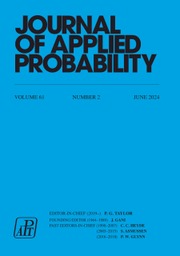Crossref Citations
This article has been cited by the following publications. This list is generated based on data provided by
Crossref.
Halfin, Shlomo
1985.
The shortest queue problem.
Journal of Applied Probability,
Vol. 22,
Issue. 4,
p.
865.
Blanc, J.P.C.
1987.
On a numerical method for calculating state probabilities for queueing systems with more than one waiting line.
Journal of Computational and Applied Mathematics,
Vol. 20,
Issue. ,
p.
119.
Blanc, J. P. C.
1987.
A note on waiting times in systems with queues in parallel.
Journal of Applied Probability,
Vol. 24,
Issue. 2,
p.
540.
Rao, B. M.
and
Posner, M. J. M.
1987.
Algorithmic and approximation analyses of the shorter queue model.
Naval Research Logistics,
Vol. 34,
Issue. 3,
p.
381.
Gubner, John A.
Gopinath, B.
and
Varadhan, S. R. S.
1989.
Bounding functions of Markov processes and the shortest queue problem.
Advances in Applied Probability,
Vol. 21,
Issue. 4,
p.
842.
Nelson, R. D.
and
Philips, T. K.
1989.
An approximation to the response time for shortest queue routing.
p.
181.
Nelson, R. D.
and
Philips, T. K.
1989.
An approximation to the response time for shortest queue routing.
ACM SIGMETRICS Performance Evaluation Review,
Vol. 17,
Issue. 1,
p.
181.
Boel, R.K.
and
van Schuppen, J.H.
1989.
Distributed routing for load balancing.
Proceedings of the IEEE,
Vol. 77,
Issue. 1,
p.
210.
Adan, I. J. B. F.
WESSELS, J.
ZIJM, W. H. M.
and
Nederlandse Philips Bedrijven, B. V.
1990.
J.comput. appl. math.
Communications in Statistics. Stochastic Models,
Vol. 6,
Issue. 4,
p.
691.
Winsten, C.B.
and
Fryer, M.J.
1990.
Duality properties of a one-dimensional random walk and a new computational algorithm.
European Journal of Operational Research,
Vol. 44,
Issue. 3,
p.
414.
Adan, I. J. B. F.
WESSELS, J.
and
Zijm., W. H. M.
1991.
Analysis of the asymmetric shortest queue problem with threshold jockeying.
Communications in Statistics. Stochastic Models,
Vol. 7,
Issue. 4,
p.
615.
Adan, I. J. B. F.
Wessels, J.
and
Zijm, W. H. M.
1991.
Analysis of the asymmetric shortest queue problem.
Queueing Systems,
Vol. 8,
Issue. 1,
p.
1.
Zhao, Yiqiang
and
Grassmann, Winfried K.
1991.
A numerically stable algorithm for two server queue models.
Queueing Systems,
Vol. 8,
Issue. 1,
p.
59.
Menich, Ronald
and
Serfozo, Richard F.
1991.
Optimality of routing and servicing in dependent parallel processing systems.
Queueing Systems,
Vol. 9,
Issue. 4,
p.
403.
Lui, John C. S.
and
Muntz, Richard R.
1992.
Algorithmic approach to bounding the mean response time of a minimum expected delay routing system.
p.
140.
Lui, John C. S.
and
Muntz, Richard R.
1992.
Algorithmic approach to bounding the mean response time of a minimum expected delay routing system.
ACM SIGMETRICS Performance Evaluation Review,
Vol. 20,
Issue. 1,
p.
140.
Hordijk, Arie
and
Koole, Ger
1992.
On the Shortest Queue Policy for the Tandem Parallel Queue.
Probability in the Engineering and Informational Sciences,
Vol. 6,
Issue. 1,
p.
63.
Sundaram, C. R. M.
and
Narahari, Y.
1993.
Application and Theory of Petri Nets 1993.
Vol. 691,
Issue. ,
p.
397.
Nelson, Randolph D.
and
Philips, Thomas K.
1993.
An approximation for the mean response time for shortest queue routing with general interarrival and service times.
Performance Evaluation,
Vol. 17,
Issue. 2,
p.
123.
Adan, Ivo
van Houtum, Geert-Jan
and
van der Wal, Jan
1994.
Upper and lower bounds for the waiting time in the symmetric shortest queue system.
Annals of Operations Research,
Vol. 48,
Issue. 2,
p.
197.


